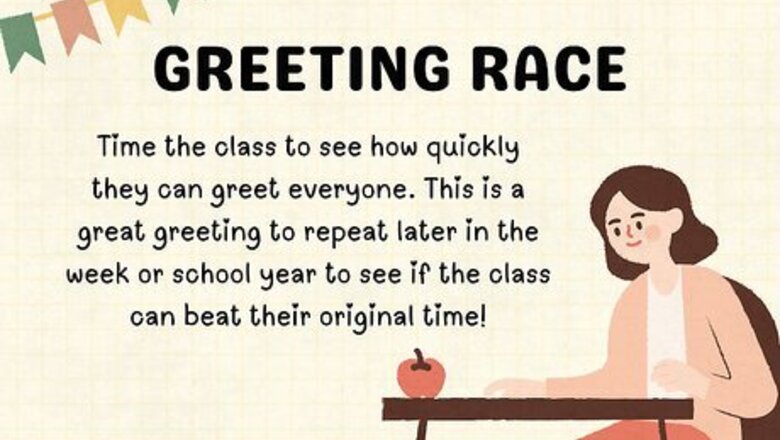
views
Engaging Morning Meeting Greetings for the Classroom
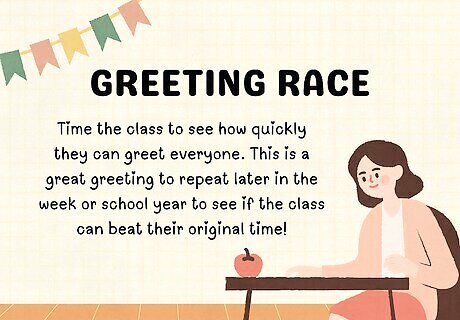
Greeting race In this greeting, students will be timed to see how quickly they can pass a greeting around the classroom. First, say “good morning to one student” and address them by name (“Good morning, Becky!”). Have the student say “good morning” back to you (using your name), then have them say “good morning” to another student. That student will say “good morning” back, then choose a new student to greet, and so on. Time the class to see how quickly they can greet everyone. This is a great greeting to repeat later in the week or school year to see if the class can beat their original time!
“Good morning to anyone who…” Choose one student to lead the morning greeting and have them stand in front of the class. They’ll say “Good morning to anyone who…” and include a fact that could be true for their classmates (for example, “Good morning to anyone who’s looking forward to recess!”). Anyone who agrees with the greeting statement will stand up and say good morning to each other, then sit back down. Have the leader say a few more greetings and facts to engage all members of the class. Students will likely be enthusiastic to lead this one!
Math card matching This is a great greeting to reinforce any math skills you’re teaching. Pre-make a card for each student that has a portion of a math equation on it (for example, “10x3”). Then, have students mingle and try to find the match for their card (in this case, “=30” is the match for “10x3”). When they find each other, student pairs will greet each other and sit down together in a circle. When everyone has found their match, have the student pairs announce their equations for the rest of the class.
Compliment chain This greeting strengthens students’ social-emotional skills by having them give compliments to each other. Have students greet the student next to them and ask them to give a genuine compliment (“Good morning, Joe! You always know the answers in math class!”). Then, the just-complimented student will compliment the student on their other side, working through the entire class. Tip: For younger students, you may need to model what a good, authentic compliment sounds like. It helps to kick off the compliment circle yourself!
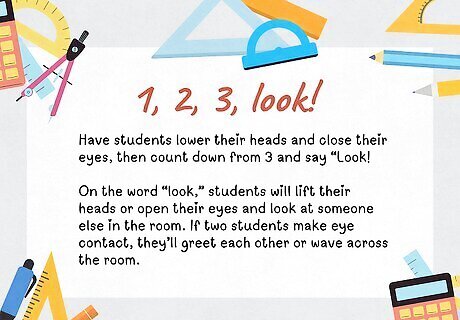
“1, 2, 3, look!” This is a fun game-style greeting that teaches students to make eye contact. Have students lower their heads and close their eyes, then count down from 3 and say “Look!” On the word “look,” students will lift their heads or open their eyes and look at someone else in the room. If two students make eye contact, they’ll greet each other or wave across the room. If a student does not lock eyes with someone, they’ll put their head back down for the next round. Continue counting down and saying “Look!” until all students have been greeted at least once.
The wave This is a great greeting to get students on their feet and have them wiggle out some energy before you start your first lesson. Have everyone stand in a circle with their arms extended on both sides so that students’ palms are touching or facing each other. Turn to the student on your left and say, “Good morning, Miranda!” The student will greet you back, then you’ll both raise your arms in a wave motion. Continue greetings in this pattern until the wave has traveled all the way around the circle.
Wake up greeting Have students sit at their desks with their heads down and eyes closed. Say “good morning” to one student by name. That student will raise their head and open their eyes, like they’re “waking up.” Then, they’ll greet another student whose head is still down. The greeting continues until everyone is “wide awake!” This is a good game-style greeting to try if your class is being a bit rowdy and you want them to take a moment to be quiet and listen before starting the day.
“Would you rather…” Choose a few “Would you rather?” questions ahead of time to ask your class (for example, “Would you rather have a window seat or an aisle seat on the school bus?”). Ask the question, then have students who choose one answer stand and students who choose the other answer stay in their seats. Encourage the class to look around the room to discover who they have something in common with! Ask a handful of questions to extend the activity, or have students come up with and share questions, too.
Spider web For this greeting, you’ll need a large ball of yarn. Have all students sit in a circle. When a student greets someone else, they’ll roll the ball of yarn to them, holding onto the end of the yarn to create a strand of the “web.” Students will continue greeting each other and rolling out the yarn until everyone has been greeted and there’s a giant spider web on the ground! For an added challenge, have students unravel the web by greeting each other in reverse order and re-rolling the ball of yarn.
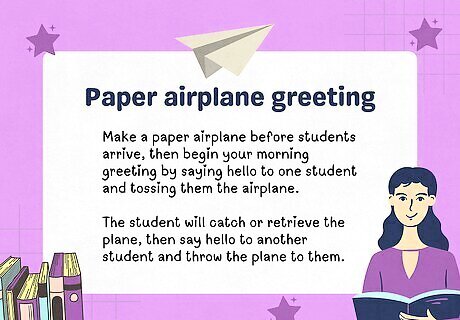
Paper airplane greeting Make a paper airplane before students arrive, then begin your morning greeting by saying hello to one student and tossing them the airplane. The student will catch or retrieve the plane, then say hello to another student and throw the plane to them. Repeat until everyone has been greeted and gotten to throw the plane. Remind students to throw the plane carefully, and that the only person allowed to catch or retrieve the plane is the student being greeted.
Sharing with partners This morning greeting emphasizes active listening skills. Provide a prompt question for the class (like, “What is something you’re looking forward to this weekend?”). Then, have students get into pairs and share their answers with each other. Remind students to listen to each other carefully, because when time is up, they’ll have to present what their partner is looking forward to to the class!
“Pop!” quiz This greeting is great for recalling information students learned in an earlier class. Choose several questions to ask about a topic you’re teaching, like “What’s something you learned about ancient Greece this week?” or “What’s something you remember from our field trip to the zoo?” To answer, students have to yell “Pop!”, but if two or more students say it at the same time, neither gets to share. Students can only answer if they sneak in a solo “Pop!” The activity ends when you’ve run out of time or when each student has gotten to answer a question.
Book club This greeting helps strengthen students’ book summary and language arts skills. Have each student share a book they read (or are currently reading), including some details that would get other students interested in the book as well. You may have to demonstrate how to talk about a book first (for example, including the title and author, stating what the premise of the book is, providing some details without giving away the entire plot, etc.). This exercise is more appropriate for older elementary students and may not be engaging enough for younger students. Bonus tip: Make a list of everyone’s book choices to create your own classroom book club reading list!
“Say your name” chant Have the entire class chant the refrain, “Say your name and when you do, we will say it back to you!” The first student up will say their name, then the rest of the class will repeat their name in unison. Then, have everyone chant the refrain and continue moving on to other students until everyone has said their name. This is a great icebreaker game for the beginning of the school year when students may still be getting to know each other. For more variety, encourage each student to say their name in a different style (loud, soft, high-pitched, long and drawn out, etc.) and have the class repeat it in the same manner.
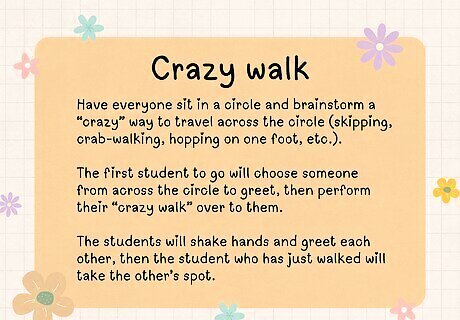
Crazy walk This is a fun movement-based greeting to help students shake off some energy. Have everyone sit in a circle and brainstorm a “crazy” way to travel across the circle (skipping, crab-walking, hopping on one foot, etc.). The first student to go will choose someone from across the circle to greet, then perform their “crazy walk” over to them. The students will shake hands and greet each other, then the student who has just walked will take the other’s spot. Then, the student who was just greeted will choose someone new, perform their crazy walk over to them, and the pattern continues until everyone has gone.
Chain reaction Pick a friendly discussion question to start the day with (for example, “What’s your favorite thing about the fall?”). Then, choose one or two students to begin the game. These students will share their answer to the question with someone near them. Then, the listener will share their answer with a third student who’s near them, and on and on until everyone has gotten to share with somebody.
Snowball fight This is a fun activity to help burn off some energy in the wintertime. Have each student write their name on a piece of paper and then crumple it into a ball. When you say “Go,” students will throw their “snowball” into the center of the classroom. Each student will then grab a snowball, open it up, and go greet the person whose name is on the paper. For an extra creative touch, have students decorate their paper with winter-themed designs like snowflakes, snowmen, mugs of hot chocolate, or whatever else they like. You can have students throw their snowballs multiple times to extend the activity.
The frog Another active greeting! Have students get into pairs, then have each student squat low to the ground (like a frog about to leap). Then, have each pair jump up into the air and clap their hands together while they take turns saying “Good morning, [name]!” You can repeat this one several times so students get to greet a handful of classmates (and to wear out a particularly rowdy class!).
Guess who? This mystery activity will fill your morning greeting time for the whole week! On a Monday, have each student write down 3 facts about themselves that no one else is likely to know. Collect the answers, then read a few facts aloud each day throughout the week during morning meeting and ask, “Guess who?”. Students will get about 3–5 chances to guess who the fact belongs to. If a student guesses the answer correctly, the person who wrote the fact will reveal themselves. If no one can guess the right answer, put the fact card back in the pile to read later in the week when the options have been whittled down.
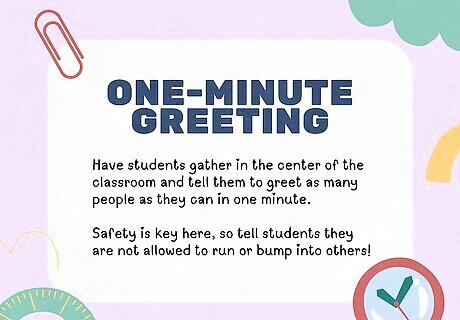
One-minute greeting Have students gather in the center of the classroom (or wherever there is an open area) and tell them to greet as many people as they can in one minute. Remind students to include all the parts of a greeting (eye contact, saying the person’s name, using a friendly voice, etc.) to avoid impersonal or “throwaway” greetings. Safety is key here, so tell students they are not allowed to run or bump into others!
Lumberjack greeting This greeting game is a silly variation on a handshake. Students will go around the room greeting each other and shaking hands. Instead of a classic handshake, students will clasp hands and “saw” back and forth, as if they’re cutting wood. While they’re sawing, have them say “Good morning, [name]!” and share a compliment, fun fact, or lighthearted observation about something in the classroom.
Alphabetical greeting Working on how to alphabetize in class? Then this greeting is perfect! Ask students to greet each other, going in alphabetical order by first name. Have younger students who are just learning to alphabetize start with A names (or whichever name in your class comes first in the alphabet). Challenge older students to begin anywhere in the alphabet and loop back to A names after all the Z names. This exercise is helpful for getting students to focus on one collective task.
Marble giveaway greeting Give each student 3 marbles (or other small objects) to pass around during the greeting. Have students mingle with each other around the classroom and say “good morning” to each other. Every third person that a student greets receives one of their marbles. When a student has given away all 3 of their original marbles, have them sit down.
Ball toss greeting Have students sit or stand in a circle, then choose one student to start the game and hand them a ball. When they greet another student, they will gently toss, roll, or bounce the ball to that student, who will greet them back. Then, the student who receives the ball will greet a third student and send them the ball. The pattern continues until everyone has gotten to receive and pass the ball. Tip: An underhand toss is best for small or soft balls. For large or bouncy balls, a roll or bounce is more controllable.
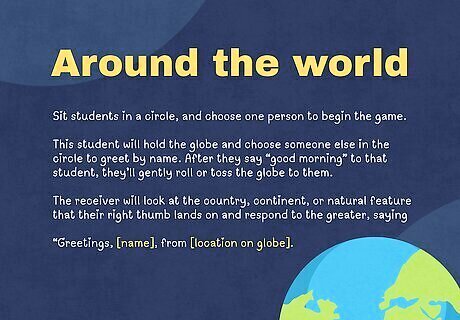
Around the world For this geography-based activity, you’ll need a large inflatable globe. Sit students in a circle, and choose one person to begin the game. This student will hold the globe and choose someone else in the circle to greet by name. After they say “good morning” to that student, they’ll gently roll or toss the globe to them. The receiver will look at the country, continent, or natural feature that their right thumb lands on and respond to the greater, saying “Greetings, [name], from [location on globe].” For example: Student 1 (John): “Good morning, Sarah!”(Sarah catches the ball and her right thumb lands on Australia.)Student 2 (Sarah): “Good morning, John, from Australia!”
Tah dah! Have students sit in a circle. The first student to go will name someone across from them and say, “Good morning, [name]!” The students on either side of the greeted person will say their name and make a “tah dah!” motion with their hands and fingers (like jazz hands, or however you want to interpret it). The greeted student goes next and chooses a new student to greet. Keep going until everyone has been greeted.
Adjective greeting This greeting is appropriate for older elementary students who are learning adjectives and other parts of speech. First, spend a few minutes reviewing what adjectives are and brainstorming a list of adjectives for every letter of the alphabet (you’ll want at least 2-3 adjectives for each letter). Then, have each student pick an adjective that starts with the same letter or sound as their name. They’ll go around the class and introduce themselves as “[adjective][name].” For example, a student named Hannah might say, “Good morning, my name is Happy Hannah!”
Electric circle Have all students stand in a circle and hold hands. Choose one student to start. That student will squeeze the hand of their neighbor, who will then pass the squeeze on to their neighbor, all the way around the circle (just like an electric charge moving through a wire!). The goal is to greet everyone and pass the squeeze around the circle as quickly as possible.
Your royal “Hi”-ness Looking for a creative, theatrical morning greeting? Instruct students to use their best “royal”-sounding voice and greet each other with bows, curtseys, and formal language you might hear in a royal court. These could be phrases like: “Good morning, my dear fellow.” “I bid you good day, madame.” “Top of the mornin’ to you, sir.” “Good day, m’lady.”
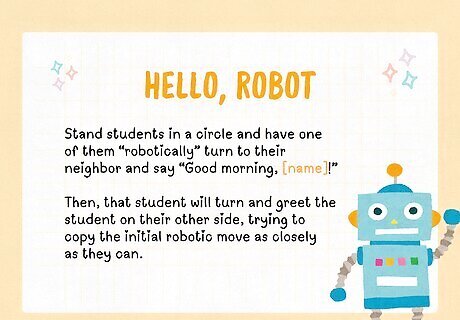
Hello, robot For another theatrical greeting game, instruct students to pretend they’re robots and use their best, robot-like voices and movements. Stand students in a circle and have one of them “robotically” turn to their neighbor and say “Good morning, [name]!” Then, that student will turn and greet the student on their other side, trying to copy the initial robotic move as closely as they can. The greeting ends when everyone has gotten to greet their robot neighbor.
Weekend wishes This is a fun greeting to use at the end of the school week. Have everyone gather in the center of the class or in a circle and whisper one wish they have for the weekend into their hands. Then, on the count of 3, have all students release their wishes together in loud, excited voices! As a variation, have students greet each other one by one, sharing their wish after they receive a greeting.
“Find a friend who…” Have students take their seats, then stand in front of the class and say, “Find a friend who…”, followed by a hobby, interest or statement (like, “...who likes ice cream” or “...whose favorite subject is social studies”). If a student likes the thing you mentioned, they’ll stand up and exchange greetings with others who also stood up.
Rollin’ the dice For this greeting game, you'll have one or two dice. Seat students in a circle, then give one student the dice to kick off the game. That student will roll and announce the number out loud (for example, “Five!”). That student will then count 5 spaces around the circle from them and greet whoever is in that 5th spot, taking their place. Then, the greeted student will roll the dice and continue the greeting. Continue playing until each student has gotten a chance to roll the dice and greet someone.
Foreign language greeting This is a great greeting to teach students how to say “hello” in other languages. First, pick a language and teach the class how to say “hello” or “good morning” in it (for example, hola in Spanish, bonjour in French, as-salamu alaykum in Arabic, etc.). Then, have students greet each other in that language—no English allowed! This is an easy greeting to repeat with new languages, or you can stick with one language and introduce multiple phrases (like “hello,” “good morning,” or “how are you?”).
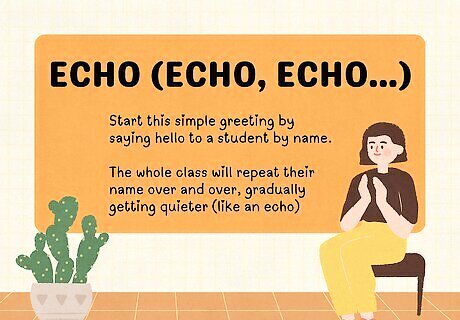
Echo (echo, echo…) Start this simple greeting by saying hello to a student by name. The whole class will repeat their name over and over, gradually getting quieter (like an echo). Continue greeting each student by name so the class gets to echo everyone!
Keeping Students Engaged During Morning Meeting Greetings
Keep your greetings age-appropriate to hold students’ interest. It’s common for students to be excited about morning meeting greetings at the start of the year, but their enthusiasm can wane if they feel the greeting isn’t interesting or challenging enough for where they are developmentally. So, aim to incorporate greetings that are fun and engaging for the age you teach. For example, a greeting like “Echo (echo, echo…)” may be fun for a class of 1st or 2nd graders, but feel too simple or childish for older elementary kids. Similarly, an academic-based greeting like “Around the world” may be more stimulating and appropriately challenging for older students than those in grades K-3. EXPERT TIP Taylor Klein Taylor Klein Advanced Math Teacher Taylor Klein is an Advanced Math Teacher based in Philadelphia, Pennsylvania. She has worked in the education field for over 10 years, including eight years as a middle school Advanced Math Teacher. She has a master’s degree in Instructional Technology and Design and a master’s degree in Educational Leadership and Administration. Taylor Klein Taylor Klein Advanced Math Teacher The social-emotional learning aspect of education is something some teachers overlook. The most important thing in keeping students engaged in the classroom is creating an environment where they feel heard, seen, and safe. I have found that the most engaged students are the ones who feel comfortable in their space.
Remember that greetings don’t have to be loud and boisterous to be engaging. The best learning comes from real engagement (not just loud participation), so choose greetings that you think will keep your students focused on the activity rather than simply entertained by it. For example, greetings that use props (like “Spider web”) encourage students to be engaged the whole time because they have a physical item to interact with. Or, games that require intense focus to pull off (like “1, 2, 3, Look!”) can keep students engaged too, even though they spend most of the activity quietly with their heads down.
Change up the greeting style to add variety to the week. Avoid scheduling too many greeting games that are similar to each other in the same week (for example, having multiple greetings where you stand in a circle and say “Hello” to your neighbor back-to-back). This makes morning meetings more exciting for students because it’s less predictable, and students may start to look forward to coming to school because they know they’ll have a new, fun activity waiting for them. You could even ask your students to help you craft a new greeting that’s unique to your class so they feel more ownership over morning meetings. According to advanced math teacher Taylor Klein, “creating an environment where the students feel like they are in control of the rules and where they help create the environment” is a great way to keep them engaged in class! However, it’s OK to repeat greetings if your students are still engaged and enthusiastic about playing them. As the old saying goes, “If it ain’t broke, don’t fix it!”

















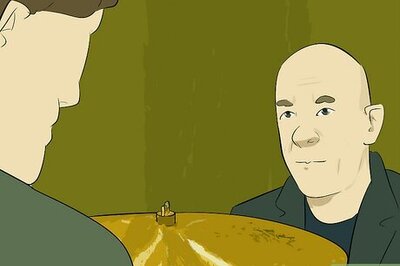


Comments
0 comment